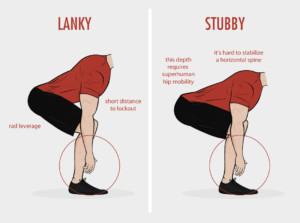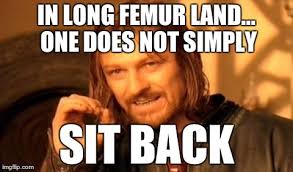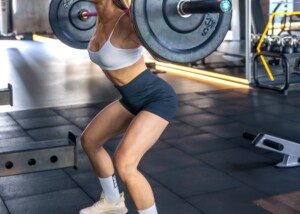
There’s a reason why a skinny ectomorph may be able to lift an impressive amount of weight and seem quite strong.
The ectomorphic body type is characterized by being “naturally thin,” in that this person eats more than what their body suggests.
In addition, the ectomorph struggles to put on muscle; this is the type of individual who pounds out the weightlifting routines and still sees no muscle growth, while his buddies pack on muscle just from looking at a barbell.
However, a skinny ectomorph every now and then might be seen deadlifting an unbelievable amount of weight — unbelievable for the amount of weight on the lifter’s lanky frame.
I’ve seen this more than once and wondered, How can this be?
The answer is LEVERS.

There’s more to how much weight a person can move than just how big their muscles are.
That thin ectomorph with the pipe cleaner arms will have a biomechanical advantage in the deadlift if the span of his outstretched arms exceeds his overall height by several inches, and if his femurs are shorter than his torso.
Having large hands will also help.
• Regardless of overall body height, whether he’s 5-7, 5-11 or 6-3, if his arm span is greater than his height by, say, four inches, his hands will be a few inches closer to the barbell than if his arm span were equal to his height.
• This means he will not have to bend over as far to grab the barbell. Two inches may seem puny, but for the deadlift, that extra two inches changes the game.
• By not having to lean over as much, his lower spine isn’t as stressed as it would be if he had to lean over more.
• This is easy to understand when you imagine how much easier it would be to pick up a heavy object if it were setting on a two-inch platform that’s on the floor vs. directly on the floor.
• Another way to understand this is to imagine picking a heavy object off the floor—while standing on a two-inch ledge, vs. standing directly on the floor.
The two-inch ledge forces you to bend over more, placing more strain on the lower back. Or, it forces you to squat deeper, creating a more difficult starting point.
• It’s easier to pick up the heavy item standing directly on the floor.
• It’s even easier if the heavy item was elevated two inches!
Femur to Torso Length Can Make Skinny Ectomorph Seem Strong
If this thin ectomorph with the “chicken legs” has a torso that’s a lot longer than his femurs, this, too, puts him at a biomechanical advantage with the deadlift, regardless of overall body height.
If his femurs are several inches shorter than his torso, his hips are closer to the plane of the barbell than they’d be if his femurs were an inch longer than his torso.
With his hip region being closer to the plane of the barbell, he doesn’t have to lean over as much to pick it up.
The long femur, short torso build would force his hips back out further in the starting position of the deadlift, forcing him to lean over more to grab the barbell.
This additional leaning over would put him in a biomechanical disadvantage: more strain on his lower spine.
To lean over LESS, a short-armed and/or long femur person would have to squat down deeper in the start position.
At the start of the deadlift his femurs would have to be nearly parallel to the floor!
A long armed, short femur person wouldn’t have to bend over as much, and at the same time, would have less bent legs in the start position, instead of legs close to the half squat position.
The end result is a skinny lanky person hoisting up a 225 pound barbell for eight reps.
A muscled man (mesomorph) with thick legs comes by — and to make this a bit easier to follow — let’s just say he’s the same height as the skinny ectomorph.
But his femurs are longer than his short torso, and he has “T-rex” arms (span is four inches SHORTER than his overall height).
Dang, he’ll need to bend so far over for the start position of the deadlift that his back will be parallel to the floor at the start of every repetition, AND…his thighs will be virtually parallel to the floor, too!
He’ll be able to pull the weight, but he’ll be relying more on muscle development to do it, while straining his low back more.
The back of his thin friend, however, will be more upright in the start position, and the angle of his hamstrings to calves will be a lot greater than 90 degrees!
His start position is similar to the other man’s RACK PULL start position!
All of this becomes easier to understand if you imagine the skinny ectomorph with arms so long that his knuckles practically drag along the floor when he walks (minimal leaning forward to pick something up off the ground), while the muscleman’s arms are like a T-rex. Imagine a T-rex trying to pick something heavy off the floor!
What about someone with a build like the man at the top of this article?
Can someone like HIM actually pull 225?
I wouldn’t bet on it. There are different ways that a man (or woman) can appear “skinny” or “thin.”
The man at the top of this post not only is thin, but he has no muscle development.
A truly “skinny fat” individual, such as the guy below, won’t be posting high numbers in the gym.

Meanwhile, there ARE “thin” people — clearly ectomorphic — who actually have a trained appearance: muscle development, though not the so-called thick muscle.
Nevertheless, they’ve been training hard with barbells and, along the way, have developed strong joints as well as muscle.
If this latter group has the right proportions, they WILL have a biomechanical advantage in the big lifts.
Meanwhile, the guy at the top of this article would probably blow out a vertebral disc just trying to pull 175.


























